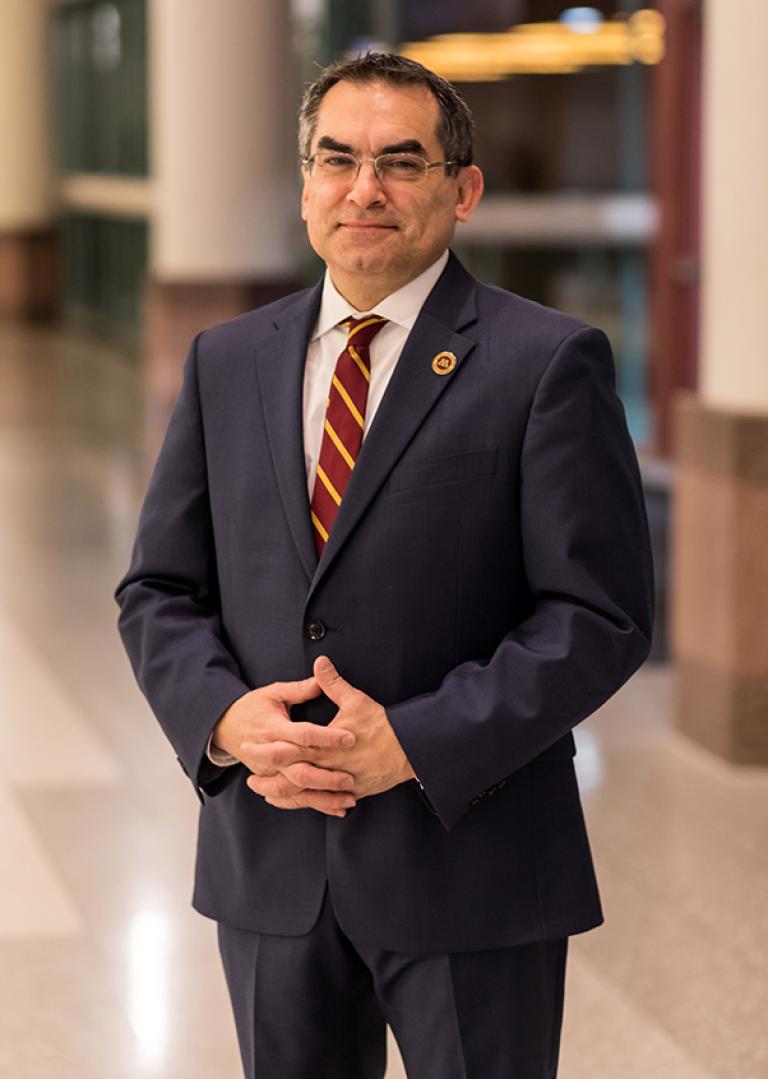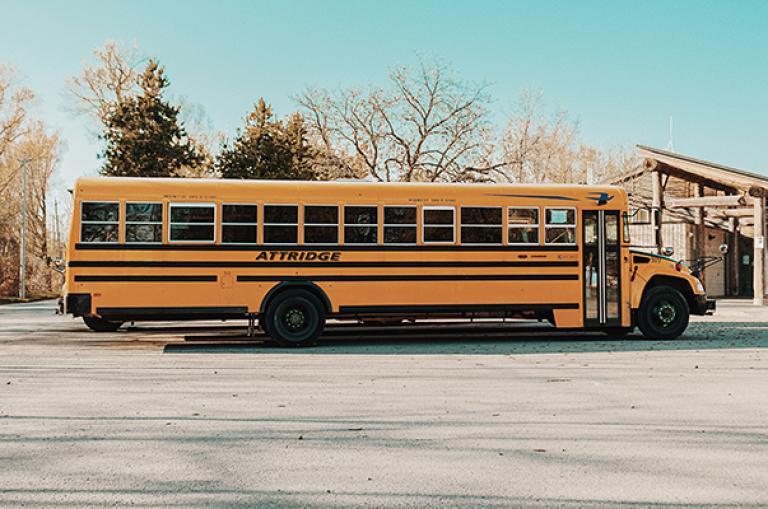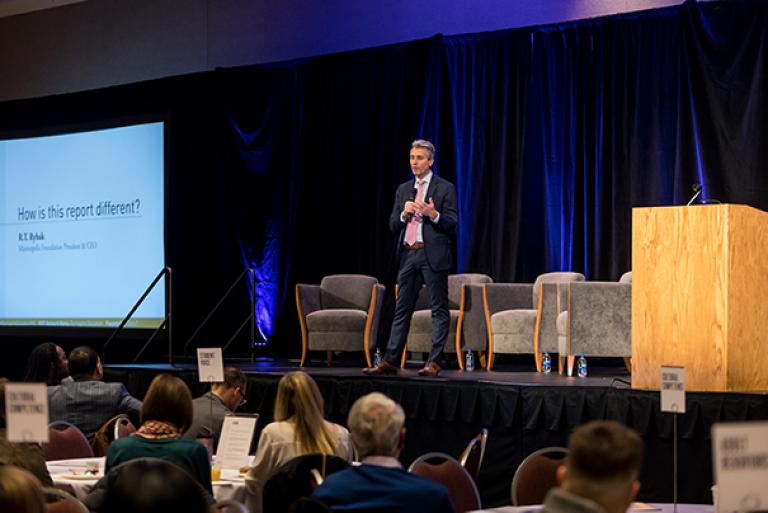2020 Spring / Summer

A vision for all students (and teachers)
With Minnesota facing a lawsuit over educational disparities produced by segregation, a group of CEHD researchers offer a roadmap to a more equitable future.
In March 2019, Michael Rodriguez, associate dean for undergraduate education, diversity, and international initiatives, received an urgent call from R. T. Rybak. The former Minneapolis mayor, now president and CEO of the Minneapolis Foundation, had just spoken with Minnesota Attorney General Keith Ellison. A recently filed lawsuit, Cruz-Guzman v. State of Minnesota, asserted that the state had failed in its constitutional duty to ensure equal education opportunities for all students—opportunities that racial segregation and discrimination had closed off.
Ellison, who is managing the state’s response to Cruz-Guzman, needed expertise regarding the state’s educational disparities. That’s why he sought out Rybak. As a longtime champion for educational equity, he would be in a prime position to connect the suit’s mediator with relevant research.
Rybak knew just where to turn. In 2018, an association of Twin Cities-area school superintendents released Reimagine Minnesota: A Collective Education Roadmap for Action. The report put forth nine key strategies for achieving greater educational equity in Minnesota. “R. T. asked whether we could bring some people from the U together and provide a research-based study and recommendations to augment that report,” Rodriguez says.
Rodriguez knew that Reimagine Minnesota had been developed “through multiple conversations in the communities—with community partners, families, teachers, and students. So it was really a great basis upon which to do additional work.”
Last summer, Rodriguez convened 12 CEHD professors and researchers to summarize the research evidence and develop action steps based on Reimagine Minnesota. The Minneapolis Foundation provided the funding, with additional support coming from the Greater Twin Cities United Way and the Saint Paul & Minnesota Foundation. In December, Rodriguez and his team released Expanding the Vision of Reimagine Minnesota. The 92-page study offers evidence-based solutions and actions designed to move the Reimagine Minnesota vision into the future.
Expanding the Vision has already gotten the attention of educators and legislators—and the legal decision-makers who will determine the settlement of the suit.
Cruz-Guzman “essentially concerns educational disparities,” Rodriguez notes. “But even more fundamentally, it asserts that school segregation has produced those disparities.” The suit is currently in mediation, with both sides working to develop a resolution. There is more at stake than segregation and resource allocation, he says: “What happens within buildings is perhaps even more important than what happens between buildings.” Cruz-Guzman “is likely to change how public education is delivered in the Twin Cities,” Rodriguez adds. And Expanding the Vision’s research and proposals are likely to help determine what those changes look like.
Building on the foundation
Rodriguez and Rybak had previously worked together on Education Equity in Action, an event CEHD held in 2016 and 2017 that had explored ways to address racial disparities in education. Before joining the Minneapolis Foundation in 2016, Rybak had served as executive director of Generation Next, a public-private collective impact coalition focused on closing education opportunity gaps in Minneapolis and St. Paul for children of color.

Rybak knows that “there are plenty of reports on education equity, and they’re sitting on some very dusty shelves.” In contrast, the teachers, administrators, and students that contributed their insights to the Reimagine report “have a very direct connection to the work. Once you establish those participants at the center, especially students, the rest of us can talk about how we can enhance what they have presented. That’s opposed to the well-intentioned but wildly unsuccessful dynamic of a bunch of smart people on the outside saying to students and educators, ‘Step aside and let us show you how brilliant we are.’”
It’s the interweaving of scholarship and real-life experience, along with actionable ideas rooted in implementation science, that Rybak believes sets Reimagine Minnesota and Expanding the Vision apart.
In putting together Expanding the Vision, Rodriguez and his CEHD team added a couple of topics of discussion to the original Reimagine report. One was on social and emotional learning. The other was implementation science, a field of scholarship that examines the barriers and challenges that hinder a program’s implementation, and how they can be overcome.
Each of the 12 contributors brought to Expanding the Vision insights from their scholarship. Case in point: Stefanie Marshall, assistant professor in CEHD’s Department of Curriculum and Instruction, discussed why educators seeking to overcome disparities in their schools need to think critically about how they address students from different cultural backgrounds from themselves.
“One of the main points that I wanted to get across is that school administrators need to have the capacity to support teachers and help them recognize their own biases in order to engage the learning needs of students from diverse backgrounds,” Marshall says. If funding and other support aren’t provided to do this specific work, educational reform efforts will end up “maintaining the status quo,” she adds.

In her contribution to Expanding the Vision, Tabitha Grier-Reed, a professor in the Department of Family Social Science, discussed the importance of “relationships” in education. “Anyone who really teaches and loves teaching understands that relationships are essential to teaching and learning, and that these are complex, multifaceted relationships,” Grier-Reed says. But schools aren’t designed that way. Especially in the higher grades, schools are organized around dispensing information as though the students are empty vessels to be filled with knowledge.
But the science of education has advanced, Grier-Reed notes: “Now people know about constructivist learning environments—and environments where students and teachers co-create knowledge,” Grier-Reed says. “It’s just taking a lot more time to become a new standard for organizing education at all levels, especially in the middle and secondary level. Elementary schools are actually pretty different—their classes are much more organized around relationships and helping the whole child develop.” With older students, however, the emphasis is more on delivering “content”—math content, social studies content, and so on.
What’s needed, Grier-Reed believes, is to bring the current science of pedagogy, teaching, and learning to bear on how all children from different backgrounds are educated in Minnesota and addressing their distinctive needs and ways of learning, including their mental well-being.
“Anyone who really teaches and loves teaching understands that relationships are essential to teaching and learning, and that these are complex, multifaceted relationships.”
-Tabitha Greier-Reed
All in this together
In addition to its financial support, the Minneapolis Foundation is “in a unique position to be a community connector and a convener,” bringing together all the stakeholders in public education, says Patrice Relerford, the foundation’s director of impact strategy, education. In December, her organization, along with the University of Minnesota and the report’s other funders, introduced Expanding the Vision to educators and community leaders throughout the Twin Cities metropolitan area, with attendees from both the cities and the suburbs present. “Seeing that regional spirit of cooperation and collaboration really impressed me,” Relerford says. And the fact that attendees lingered after the event for further discussion “made me hopeful that people would embrace this.”
And even ahead of the Cruz-Guzman settlement, several Minnesota school districts have begun work on tearing down the barriers that the suit has identified. Rodriguez notes that many of the best practices and related ideas in Reimagine Minnesota and Expanding the Vision “are known and have been talked about in other arenas. There are schools that are doing many of those things. But what I worry about is schools feeling like they have to do this on their own.”

Rodriguez has been encouraging districts to network with their neighbors and with their communities in order to shrink the achievement gaps in their schools. “Many of the challenges regarding educational equity have to do with not understanding local needs and preferences,” he says. Communities are continually evolving, their demographics shifting. “We have to have really strong partnerships with community leaders and community organizations,” Rodriguez says. “Those organizations are helping match families with schools and government agencies. We could be learning so much more from them.”
Last December, the Northfield school district invited students from three other school districts to get together to discuss education achievement data. Remarkably, the data presentations were led by students from the four districts. It was “an incredible educational opportunity for the students,” Rodriguez says. Even more significant was the fact that the four districts joined forces. “To me, that’s the biggest piece: Connecting with others, working in partnership and collaboration, and not thinking that we can do this alone,” he adds.

The resolution of the Cruz-Guzman suit will very likely require school leaders throughout the Twin Cities metro area—and in many parts of Greater Minnesota—to make changes in their curricula and approaches to teachers in order to shrink the achievement disparities in their districts. “To make those efforts successful, they must also follow through on action steps described in Reimagine Minnesota and the evidence-based practices described in Expanding the Vision,” Rodriguez says. CEHD’s new study is poised to play a crucial role in these efforts. “The mediators and now the state legislature have seen—if not read—the Expanding report,” Rodriguez says. “I know the judges involved in the mediation have read it.”
For his part, Rybak believes that Reimagine Minnesota and the Expanding the Vision study have “the capacity to make education dramatically better in this state.” So what does he see as the next steps? “A couple of things we’re considering is convening more educators and school board members and increasing the input of our youth,” Rybak says. “All of which we would want to do in partnership with the University, leveraging its incredible expertise.”
Story by Gene Rebeck | Photos by Rebecca Slater; renan kamikoga/chuttersnap, Unsplash.com | Spring/Summer 2020